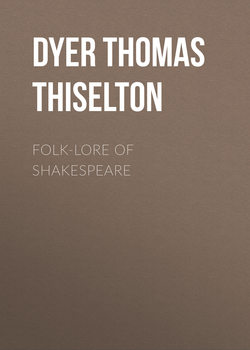Folk-lore of Shakespeare

Реклама. ООО «ЛитРес», ИНН: 7719571260.
Оглавление
Dyer Thomas Firminger Thiselton. Folk-lore of Shakespeare
PREFACE
CHAPTER I. FAIRIES
CHAPTER II. WITCHES
CHAPTER III. GHOSTS
TRANSMIGRATION OF SOULS
CHAPTER IV. DEMONOLOGY AND DEVIL-LORE
GOOD AND EVIL DEMONS
CHAPTER V. NATURAL PHENOMENA
CHAPTER VI. BIRDS
CHAPTER VII. ANIMALS
CHAPTER VIII. PLANTS
CHAPTER IX. INSECTS AND REPTILES
CHAPTER X. FOLK-MEDICINE
CHAPTER XI. CUSTOMS CONNECTED WITH THE CALENDAR
CHAPTER XII. BIRTH AND BAPTISM
CHAPTER XIII. MARRIAGE
CHAPTER XIV. DEATH AND BURIAL
CHAPTER XV. RINGS AND PRECIOUS STONES
CHAPTER XVI. SPORTS AND PASTIMES
CHAPTER XVII. DANCES
CHAPTER XVIII. PUNISHMENTS
CHAPTER XIX. PROVERBS
CHAPTER XX. THE HUMAN BODY
CHAPTER XXI. FISHES
CHAPTER XXII. SUNDRY SUPERSTITIONS
CHAPTER XXIII. MISCELLANEOUS CUSTOMS, ETC
Отрывок из книги
show how intimately he was acquainted with the history of these little people, and what a complete knowledge he possessed of the superstitious fancies which had clustered round them. In Shakespeare’s day, too, it must be remembered, fairies were much in fashion; and, as Johnson remarks, common tradition had made them familiar. It has also been observed that, well acquainted, from the rural habits of his early life, with the notions of the peasantry respecting these beings, he saw that they were capable of being applied to a production of a species of the wonderful. Hence, as Mr. Halliwell-Phillipps1 has so aptly written, “he founded his elfin world on the prettiest of the people’s traditions, and has clothed it in the ever-living flowers of his own exuberant fancy.” Referring to the fairy mythology in the “Midsummer-Night’s Dream,” it is described by Mr. Keightley2 as an attempt to blend “the elves of the village with the fays of romance.” His fairies agree with the former in their diminutive stature – diminished, indeed, to dimensions inappreciable by village gossips – in their fondness for dancing, their love of cleanliness, and their child-abstracting propensities. Like the fays, they form a community, ruled over by the princely Oberon and the fair Titania. There is a court and chivalry; Oberon would have the queen’s sweet changeling to be a “knight of his train, to trace the forests wild.” Like earthly monarchs, he has his jester, “that shrewd and knavish sprite called Robin Goodfellow.”
Of the fairy characters treated by Shakespeare may be mentioned Oberon, king of fairyland, and Titania, his queen. They are represented as keeping rival courts in consequence of a quarrel, the cause of which is thus told by Puck (“Midsummer-Night’s Dream,” ii. 1):
.....
We have already mentioned how Queen Mab had the same mischievous humor in her composition, which is described by Mercutio in “Romeo and Juliet” (i. 4):
Another reprehensible practice attributed to the fairies was that of carrying off and exchanging children, such being designated changelings.45 The special agent in transactions of the sort was also Queen Mab, and hence Mercutio says:
.....